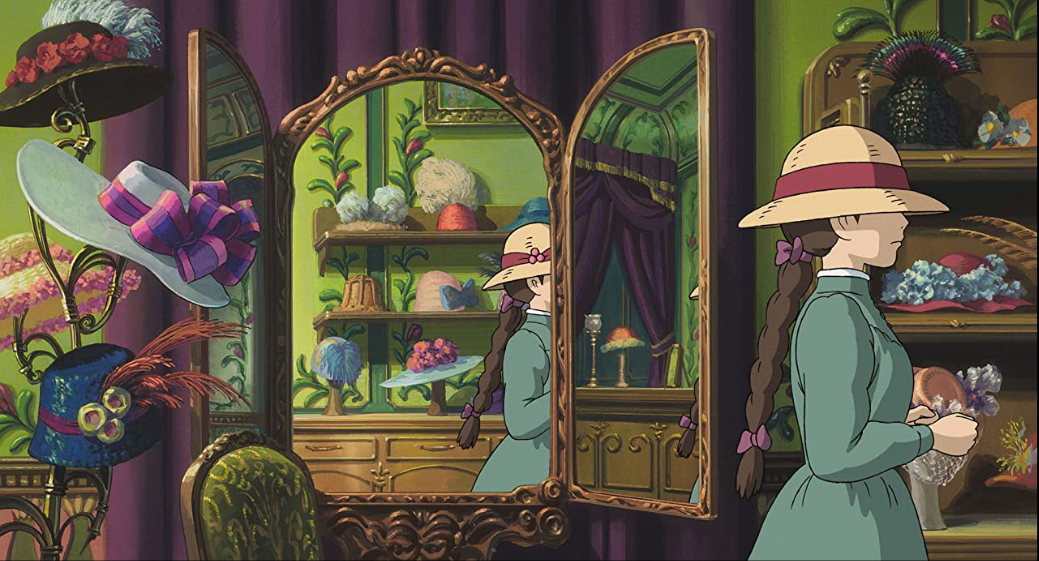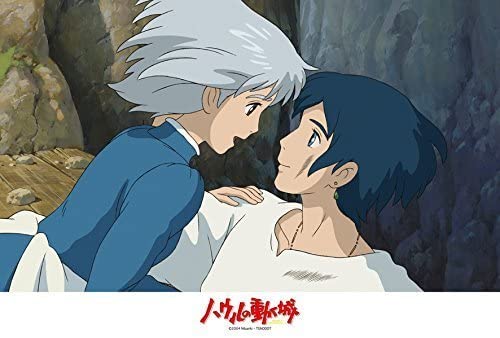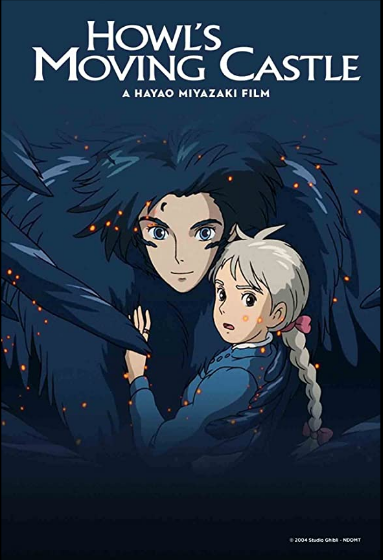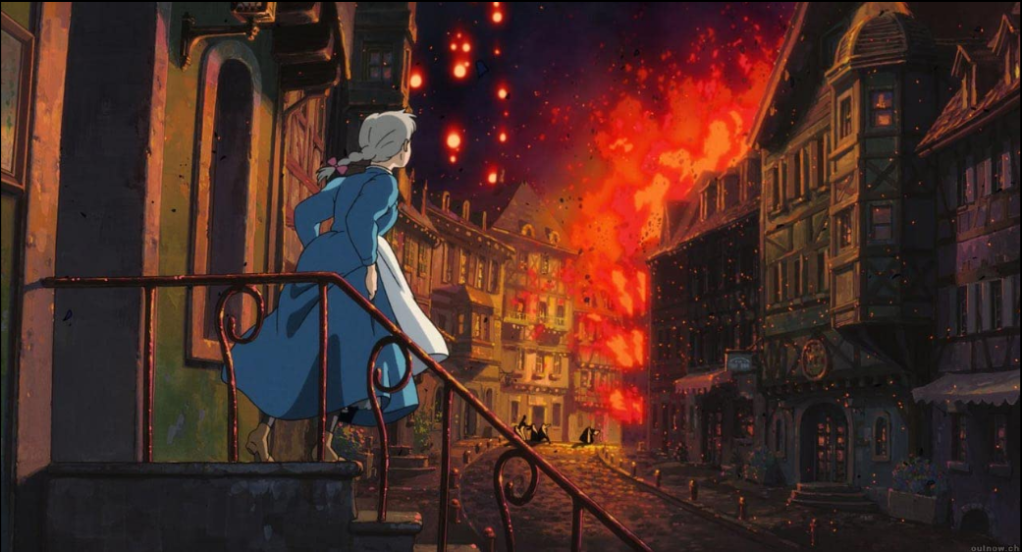Throughout my winter break, I have had the luxury of exploring the world of Hayao Miyazaki for the first time! Based on the movies that I have watched so far (which were Spirited Away (2001), Howl’s Moving Castle (2004), Princess Mononoke (1997), and Kiki’s Delivery Service (1989)), I definitely enjoy the themes and tonal atmosphere that he brings to his audiences.
And, out of all of them, Howl’s Moving Castle’s message of defining and understanding true beauty has deeply resonated in my mind the most.
Warning: Spoilers Ahead. I highly encourage you to watch the film, which is available on HBO Max and country-specific Netflix platforms. Enjoy this fantasy, romantic adventure following Sophie, a young girl who tries to break an old-age spell casted on her by working as a maid to the mysterious wizard Howl and his moving castle.
Its opening scene says so much without a spoken word: a giant, monstrous chimera of a house with an angler fish’s face, gargoyle wings, and eagle-like feet eerily marches in the mountain mist. The sound of engines creak and whir while smoke billows from its bewildering being. For audiences watching it for the first time, the impact of this scene may leave them feeling unsettled, wondering in ominous awe of the potential that this being could do.
However, once it emerges from the haze and is exposed to sunlight, its personification becomes more defined: it’s a gentle giant strolling in the hills as its image becomes paralleled to harmless, innocent sheep in the same frame–if the sheep aren’t alarmed by it, then there’s no need to worry. It is as if it were one among them.
As the title credits appear, accompanied by Joe Hisashi’s wondrous “Merry Go Round” reprising melody, viewers can now feel at ease by the presence of Howl’s Moving Castle.

The opening scene purposefully foreshadows how we will understand our characters later on. Similar to the experience of trying to understand the moving castle, the scene hints that the audience’s journey throughout the film will be witnessing countless transformations of our characters, whether it be physical or behavioral. Consequently, we will be able to learn various nuances about the cast, which will allow us to enjoy more of their wholesome personalities (which I definitely did!). This opening serves as a reminder to definitely not judge people immediately based on their appearances alone–there is more to them than meets the eye.
According to The Film Experience: An Introduction, changes in a character’s appearance throughout the film signifies meaningful character growth. For example, throughout Sophie’s seven transformations, our heroine metamorphosizes from being a timid and unconfident young woman to a carefree and outspoken old lady (and everything in between). On the other hand, Howl’s thirteen physical transformations allow us to learn that behind his mysterious handsomeness is a child who cowardly runs away from his troubles but then redeems himself as the hero who tries to save the woman he loves. In other words, to truly understand characters–and to appreciate people’s beauty in general–we must be willing to witness their stages of growth.
Through these developments experienced by our main characters and the supporting cast, Hayao Miyazaki illustrates all of the unique sides that comprises human beings, which starkly contrasts other stories that trap characters into one-dimensional, common character tropes; featuring characters with a multitude of personalities and their potential to be both good and evil essentially makes the film a much more realistic, and therefore more beautiful, reflection of humanity.
The film presents that defining human beauty is not only limited to outer appearances, but by also accepting people as a whole, welcoming both their good and bad sides.
As a case study, we must analyze the relationship between Howl and Sophie. Being a person who does not like war, Howl still has to participate in it to fulfill his wizard duties. This comes at the cost of almost losing his humanity as his involvement causes him to turn into a bird-like monster. Even so, the only reason why he does not succumb to the pure evilness of war is because his entire being is not there at the battlegrounds. Calcifer, which we find out later is Howl’s heart, is separated from his body and is used to protect his home; in other words, his moving castle is his shelter away from being emotionally and physically hurt by others and the war that rages on in the cities, respectively. The fact that his heart is that of a child and is not engaged in battle represents the preservation of his innocence–his good side. However, the more he is involved in the war, the more likely he tips towards becoming a monstrous empty shell of himself and a contributor to violence.
But enter Sophie. Her literal presence of taking care of Calcifer and cleaning Howl’s moving castle is a symbolic representation of her taking care of him. And, by her spending time with Howl, she gets to learn more about him beyond the princely image that he is known for by the women of Waste Village. She witnesses his tantrums and sees his scary transformations, but these moments never let her love waver away from him. By standing by his side and seeing all of the various personalities of Howl, she is able to be entrusted with his heart, which is proven by Calcifer’s growing fondness of Sophie. The repetitive use of opening and traveling through doors in Howl’s castle underscores the idea of her breaking down his barriers to understand where he comes from. Her ability to learn about Howl, and eventually gain and respectively earn his love, is evidently present when 1) she visits him while he is resting in his room and when 2) she is invited to Howl’s secret garden from his childhood.
These moments are not only meant to aesthetically immerse Sophie and us into his world (the dedicated animators definitely deserve great praise for the attention to detail, by the way), but also represent all the intimate intricacies that define him as a human being, which he chooses to share with Sophie and Sophie only (the intricacies being the plentitude of magical trinkets and flowers present in his room and garden, respectively). This fact parallels our own reality when it comes to allowing others to understand ourselves: we mentally put up emotional doors intentionally and only open them to those who we deem trustworthy. And the fact that Sophie is allowed this opportunity to know more about him with his permission allows their love for each other to bloom beautifully.

On the other hand, in understanding Sophie’s transformations, notice how she is easily able to revert to her youth in the presence of or the mentioning of Howl. My interpretation of her change represents her ability to be vulnerable only to him. In the very beginning of the film, she is presented to us as being unconfident of her beauty as a young girl. That is why when she turns old under the spell, she says that she finally feels that her clothes suit her age. The appearance of her old age allows her to mask the side of her that she is ashamed of: being a young girl that is, in her belief, not beautiful. However, being in Howl’s presence, she feels free to express and be herself without worrying about her looks–after all, Howl has witnessed all her personalities that are represented in her young and old age and his love for her is still immeasurable. And, within the time that she has fallen in love with him, her confidence and love for herself is restored, allowing herself to break the old-age spell to be young again. The only reason why her hair remains grey is that she has aged in wisdom gained from her adventures with Howl but her original youth remains.


To truly love someone, you have to see both sides of the person, both good and bad, and embrace them. And that is essentially what Howl and Sophie do for each other. Despite these paradoxical qualities, humanity’s existence cannot exist with one without the other. These potentials are ultimately stored in our hearts, allowing us the ability to feel and act on these emotionally moral characteristics. That is why, although having a “heart is a heavy burden,” it is still something worth having. That is the beauty of being a human.
The beauty of humanity is not only presented through the character developments of Howl and Sophie, but is also applied broadly to all of mankind throughout the movie, namely in presenting the pros and cons of our technological progress. For example, the good side of technological advancement is seen in our ability to create engines; consequently, we were able to invent trains that increase the transportation of goods and people, which birthed the establishment of cities that would thrive from these technological advancements.
(Images from Studio Ghibli/IMDb)
However, at the same time, these engines fuel the creation of weapons and artillery, which brings about our ability to forge war and create hell on earth. The image of the militarism in the movie is also seen as a sign of heroic greatness (as the city throws festivities in honor of the troops) and as source of chaos (the bombing of the village).
(Images from Studio Ghibli/IMDb)
The display of our ability to both create and destroy has been analyzed as Hayao’s stance against war and violence. Watching and reflecting on this film is synonymous to Hayao holding a mirror at humanity, showing all potentials we can be engaged in. It’s all in the matter of accepting what we choose to do for ourselves and for each other: to recklessly cause violence or unite towards a better future. Howl’s Moving Castle ultimately wants us to understand the unique differences that we have and accepting others for who they are.
That lesson is definitely something to remember, especially during these tumultuous, social times. Thank you for your words of wisdom and happy belated 80th birthday, Mr. Hayao Miyazaki. 🙂
Disclaimer: All content that is posted on this blog is only meant for discussion and entertainment purposes. Every image, video, GIF, and other created content that I post belongs to their rightful owners unless specified that the image belongs to me. Please support the official releases and content. I do not represent any entity so any words said within this blog website are from me and me alone.






